#021: Pleurotus ostreatus, The Oyster Mushroom
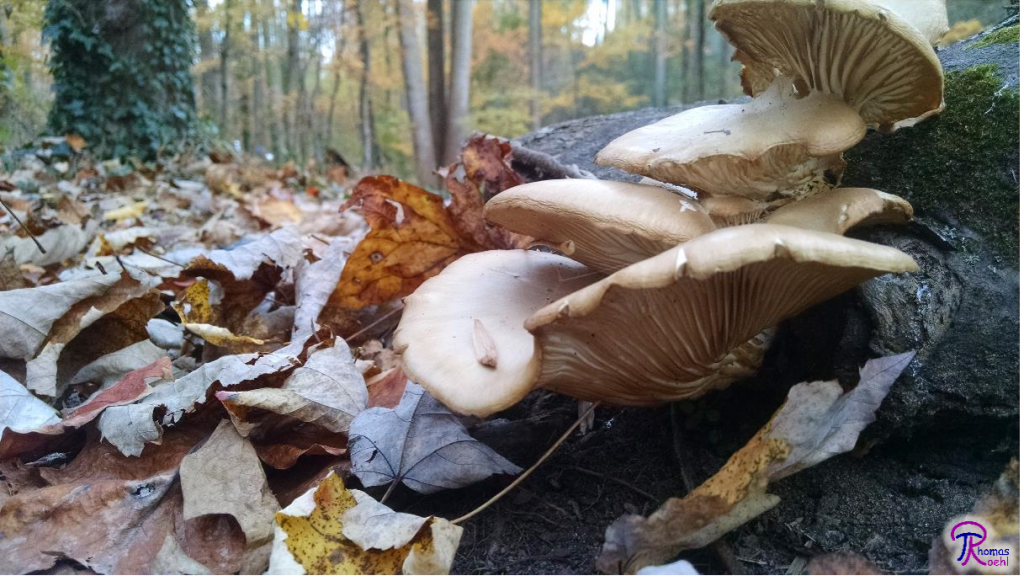
Pleurotus ostreatus is the typical pleurotoid mushroom: it has decurrent gills and a rudimentary stipe.
Pleurotus ostreatus, the “Oyster Mushroom,” is the quintessential pleurotoid mushroom: it is a gilled mushroom with a very short stalk that fruits from the sides of logs. Oyster Mushrooms are some of the best edible wild mushrooms; they are fairly easy to identify, they are meaty, and they appear in large numbers. Additionally, you find them in late fall and winter, when the woods are otherwise boring places for mushroom hunters. Although it grows on hardwood logs in nature, P. ostreatus will decompose pretty much any plant material, which makes it very easy to cultivate. As an added bonus, the Oyster Mushroom attacks nematodes. That’s one cool mushroom, right?1–3
Description
The best way to learn to identify Oyster Mushrooms is by experience. Go out on a foray with your local mushroom club or someone who knows Oyster Mushrooms and find some. Once you have some verified Oyster Mushrooms, flip them over and smell the gills. Seriously; the aroma of Oyster Mushrooms is more helpful for identification than the rest of the mushroom’s features. It’s a bit difficult to describe the odor (which is why having some in hand is so helpful), but everyone agrees it is unique to Oyster Mushrooms.1 To me, the mushrooms smell humid, sweet (almost floral), and slightly bitter. Overall, this is a pleasant smell. Cultivated oysters also have this smell, but it is muted and can be overpowered by the earthy smell of decaying woodchips, straw, or whatever the mushroom’s substrate was.
When I find something that looks similar to an Oyster Mushroom, I pick it up and smell it. This instantly tells me whether I’ve found an actual Oyster Mushroom. If you aren’t familiar with the smell, you’d have to take the mushroom home and spend a few hours taking a spore print and maybe checking its spores under a microscope to rule out lookalikes.
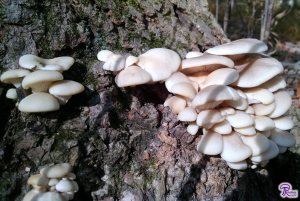
P. ostreatus often appears in clusters on logs or dead trees. In my area, the mushrooms have a particular affinity for tuliptrees. The one in this picture probably won’t be standing for much longer.
The name “Oyster Mushroom” refers to their shape and color, rather than taste. The fruiting bodies are semicircular to shell-shaped or fan-shaped, with a short or absent stipe. Oyster Mushrooms are medium-sized to large mushrooms, growing 3-25cm across or more. They sometimes appear singly, but more often fruit in clusters, which is helpful for foragers.1,3,4
The Oyster Mushroom’s pileus is semicircular to circular, depending on its position relative to its substrate. If the mushroom is on top of its substrate, there is nothing preventing it from forming a full circle. More frequently, however, the mushroom is on the side of its substrate so the cap grows into some kind of flattened circle. The cap is convex when young but tends to flatten out by maturity, sometimes becoming upturned. Its color is highly variable, ranging from whitish to grayish to brown, sometimes with faint purple tones. Darker colors often appear on the cap in thin radial streaks.1,3,4
Underneath, P. ostreatus has gills that are whitish to grayish and become yellowish with age. The most notable feature of the gills is that are long-decurrent, meaning they run very far down the stipe. It’s common to find Oyster Mushrooms with gills that run the full length of the stipe. Oyster Mushroom gills drop a lot of spores, so it’s very easy to get a spore print from these mushrooms. Like the rest of this mushroom’s features, the spore print is variable in color. Different collections drop whitish, pale yellowish, or pale purplish spores.1,3,4
The stipe of P. ostreatus poorly developed and grows just long enough to push the cap slightly away from the substrate. It is whitish in color and fuzzy below the gills, if there’s any space left between the gills and the base.1,3,4
Ecology
The Oyster Mushroom is one of the few species of mushrooms that you can routinely find at grocery stores. This is due to the fact that it is saprobic and is easy to cultivate across a range of substrates. P. ostreatus will decompose pretty much anything with cellulose, from logs to sawdust to straw to toilet paper. Oyster Mushrooms are often sold in grow-at-home mushroom kits, which are usually packed with sawdust.2 In nature the mushrooms fruit from logs or standing dead trees. Occasionally you will find them growing terrestrially from buried wood. Oyster Mushrooms prefer hardwoods but can also be found on conifers.1,3,4
P. ostreatus is one of the few large mushrooms that fruit in winter. For mushroom hunters, oyster season begins in the late fall and runs through winter. I find the most Oyster Mushrooms in November and December, just after the other large mushrooms have stopped fruiting. The mushrooms continue to appear throughout the winter, whenever the weather is favorable. Oyster Mushrooms stop fruiting sometime in the early spring. In milder climates, like that of California, the mushrooms appear year-round when the weather allows.1,3,4
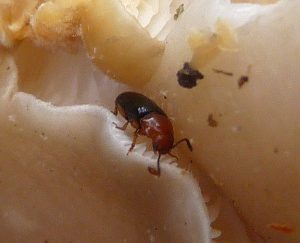
Pleasing fungus beetles in the genus Triplax are found only on species of Pleurotus. Photo by gailhampshire [CC BY 2.0], via Wikimedia Commons
One of the interesting things about P. ostreatus is that it attacks and kills nematodes. When nematodes are present, the Oyster Mushroom’s hyphae produce many sticky knobs on the sides of the cells. These secrete nematotoxic chemicals that paralyze and kill the nematodes. The fungus then produces specialized hyphae that penetrate and digest the worms. There are two reasons that the fungus would do this. First, it is a defense mechanism that prevents the nematodes from feeding on the fungal cells. Second, the nematodes supply an extra source of nitrogen. The fungus does not need an extra food source, but nitrogen is often in short supply in long-dead material.6,7 (For more on fungi that eat nematodes, see FFF#022.)
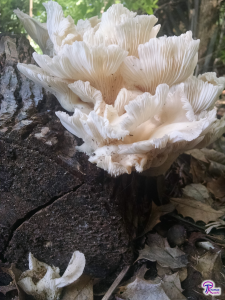
Pleurotus pulmonarius is distinguished by its lung shape, thinner flesh, and habit of fruiting during the summer.
Other Oyster Mushrooms
The name “Oyster Mushroom” actually applies to a species complex in North America. This is a group of three closely related Pleurotus species that have very similar morphologies. The complex is made up of P. ostreatus, P. pulmonarius, and P. populinus.1–4,8
Unsurprisingly, the fruiting bodies of P. pulmonarius are lung-shaped, at least when young. This separates it from P. ostreatus, which produces mushrooms that are more symmetrical. P. pulmonarius also tends to be thinner and paler than P. ostreatus. Perhaps a more useful distinguishing factor is that P. pulmonarius fruits from spring to early fall, while P. ostreatus usually fruits in fall and winter.2,8,9
P. populinus is distinguished by the fact that it will only grow on trees in the Populus genus (aspens and cottonwoods). Its cap tends to be slightly lighter than that of P. ostreatus and the mushroom gives a buff spore print, but the mushrooms are otherwise nearly identical.2,8,10
Edibility
All three species of Oyster Mushrooms are considered choice edibles, so it’s more important that you can differentiate between Oyster Mushrooms and lookalikes than among the species of oyster mushrooms.3,4,8 The Oyster Mushrooms all taste roughly the same, although people tend to like P. ostreatus mushrooms better; they reportedly have a more enjoyable texture and flavor.
Similar Species
There are a few look-alikes that you should be aware of when collecting. The first is Lentinellus ursinus, the Bear Lentinellus. It has a similar morphology and habitat to the Oysters but has serrated gills. It also tends to be much smaller and develops a hairy brown cap surface.2,11 Apparently, it is “the only mushroom that raccoons will spit out.” This is because it has a very bitter and hot taste, which makes it impossible to eat.2
Other look-alikes to avoid are members of the Crepidotus genus. Crepidotus species produce a brown spore print, which easily separates them from Pleurotus. Although Crepidotus species are for the most part nonpoisonous, eating them is not pleasant due to their poor taste and insubstantial flesh.2,8
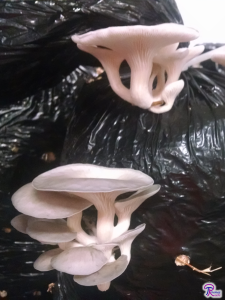
Oyster Mushrooms are easy to cultivate. You can buy them in grocery stores, grow them from kits, or culture them yourself.
Another lookalike is Pleurocybella porrigens, known as “Angel’s Wings.” It is a white shelf-like gilled mushroom with almost no stipe and a white spore print. However, it is much smaller and generally flatter than the Oyster Mushrooms. If that’s not enough, try to determine the type of wood the mushroom’s growing on; Angel’s Wings grow only on conifers, while the Oyster Mushrooms grow on hardwoods (except in rare cases). Angel’s Wings were once widely eaten, but are now considered mildly poisonous, especially to people whose liver function is impaired.8,12,13
Finally, there is Hypsizygus ulmarius, the “Elm Oyster.” This species is easily distinguished from the Oyster Mushrooms by its well-defined central stipe and attached (not decurrent) gills. It usually appears on elm and boxelder trees. The Elm Oyster is an edible species but is not as good as Oyster Mushrooms.8,14,15
Taxonomy
Oyster Mushrooms belong to the main lineage of gilled mushrooms, the Agaricales.16–18
| Kingdom | Fungi |
| Division (Phylum) | Basidiomycota |
| Subdivision (Subphylum) | Agaricomycotina |
| Class | Agaricomycetes |
| Subclass | Agaricomycetidae |
| Order | Agaricales |
| Family | Pleurotaceae |
| Genus | Pleurotus |
| Species | Pleurotus ostreatus16
Pleurotus pulmonarius17 Pleurotus populinus18 |
This post does not contain enough information to positively identify any mushroom. When collecting for the table, always use a local field guide to identify your mushrooms down to species. If you need a quality, free field guide to North American mushrooms, I recommend Michael Kuo’s MushroomExpert.com. Remember: when in doubt, throw it out!
See Further:
http://www.mushroomexpert.com/pleurotus_ostreatus.html
http://botit.botany.wisc.edu/toms_fungi/oct98.html
https://www.messiah.edu/Oakes/fungi_on_wood/gilled%20fungi/species%20pages/Pleurotus%20ostreatus.htm
http://www.mykoweb.com/CAF/species/Pleurotus_ostreatus.html
http://www.midwestmycology.org/Mushrooms/Species%20listed/Pleurotus%20species.html
Citations
- Kuo, M. Pleurotus ostreatus. MushroomExpert.Com (2017). Available at: http://www.mushroomexpert.com/pleurotus_ostreatus.html. (Accessed: 9th March 2018)
- Volk, T. J. Tom Volk’s Fungus of the Month for October 1998. Tom Volk’s Fungi (1998). Available at: http://botit.botany.wisc.edu/toms_fungi/oct98.html. (Accessed: 9th March 2018)
- Emberger, G. Pleurotus ostreatus. Fungi Growing on Wood (2008). Available at: https://www.messiah.edu/Oakes/fungi_on_wood/gilled%20fungi/species%20pages/Pleurotus%20ostreatus.htm. (Accessed: 9th March 2018)
- Wood, M. & Stevens, F. California Fungi—Pleurotus ostreatus. Available at: http://www.mykoweb.com/CAF/species/Pleurotus_ostreatus.html. (Accessed: 9th March 2018)
- Goodrich, M. A. & Springer, C. A. The Pleasing Fungus Beetles (Coleoptera: Erotylidae) of Nebraska. Transactions of the Nebraska Academy of Sciences and Affiliated Societies 62, 53–71 (1999).
- Hibbett, D. Teaching the Fungal Tree of Life-Home. Teaching the Fungal Tree of Life (2005). Available at: http://www2.clarku.edu/faculty/dhibbett/TFTOL/content/3folder/carnivorous.html. (Accessed: 9th March 2018)
- Nematode Trapping Fungi – UEA. University of East Anglia Available at: http://www.uea.ac.uk/biological-sciences/engagement/fascinating-fungi/nematode-trapping-fungi. (Accessed: 9th March 2018)
- Pleurotus ostreatus, Pleurotus populinus, and Pleurotus pulmonarius. Midwest American Mycological Information Available at: http://www.midwestmycology.org/Mushrooms/Species%20listed/Pleurotus%20species.html. (Accessed: 9th March 2018)
- Kuo, M. Pleurotus pulmonarius. MushroomExpert.Com (2017). Available at: http://www.mushroomexpert.com/pleurotus_pulmonarius.html. (Accessed: 9th March 2018)
- Kuo, M. Pleurotus populinus. MushroomExpert.Com (2017). Available at: http://www.mushroomexpert.com/pleurotus_populinus.html. (Accessed: 9th March 2018)
- Kuo, M. Lentinellus ursinus. MushroomExpert.Com (2005). Available at: http://www.mushroomexpert.com/lentinellus_ursinus.html. (Accessed: 9th March 2018)
- Emberger, G. Pleurocybella porrigens. Fungi Growing on Wood (2008). Available at: https://www.messiah.edu/Oakes/fungi_on_wood/gilled%20fungi/species%20pages/Pleurocybella%20porrigens.htm. (Accessed: 9th March 2018)
- O’Reilly, P. Pleurocybella porrigens (Pers.) Singer – Angel’s Wings. First Nature Available at: https://www.first-nature.com/fungi/pleurocybella-porrigens.php. (Accessed: 9th March 2018)
- Kuo, M. Hypsizygus ulmarius. MushroomExpert.Com (2004). Available at: http://www.mushroomexpert.com/hypsizygus_ulmarius.html. (Accessed: 9th March 2018)
- Emberger, G. Hypsizygus tessulatus. Fungi Growing on Wood (2008). Available at: http://www.messiah.edu/Oakes/fungi_on_wood/gilled%20fungi/species%20pages/Hypsizygus%20ulmarius.htm. (Accessed: 9th March 2018)
- Pleurotus ostreatus. Mycobank Available at: http://www.mycobank.org/Biolomics.aspx?Table=Mycobank&Rec=22136&Fields=All. (Accessed: 9th March 2018)
- Pleurotus pulmonarius. Mycobank Available at: http://www.mycobank.org/BioloMICS.aspx?TableKey=14682616000000067&Rec=22148&Fields=All. (Accessed: 9th March 2018)
- Pleurotus populinus. Mycobank Available at: http://www.mycobank.org/BioloMICS.aspx?TableKey=14682616000000067&Rec=53709&Fields=All. (Accessed: 9th March 2018)


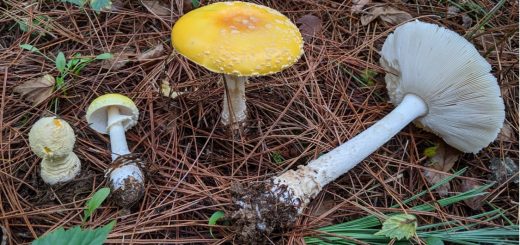
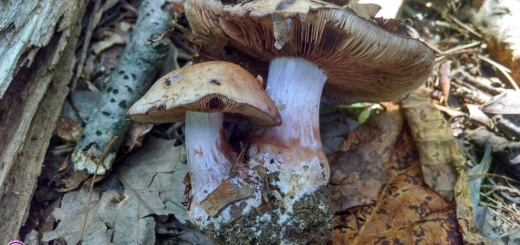





![#011: Characteristics of Kingdom Fungi [Archived]](https://www.fungusfactfriday.com/wp-content/themes/hueman/assets/front/img/thumb-small-empty.png)

1 Response
[…] the tip: marking the gill margins with ink. In Volvariella bombycina and Pleurotus pulmonarius (see FFF#021), the marks remain at the bottom of the gill even as the gills get bigger.6,18 The tip, therefore, […]